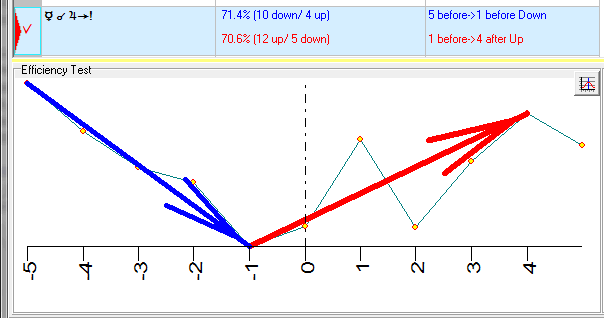
Easy Expert module
General Idea
I will demonstrate the general idea of this module on one simple example. Let's consider just one aspect - Mercury conjuncts Jupiter. It has some impact on S&P500 futures is: the price goes down before the aspect's culmination (starting 5 days before the culmination till the day before the culmination), and then it goes up within the next 5 days. If we look at the available S&P500 price history data as a whole, the price went down 10 times before the culmination (versus 4 times up) and 12 times up after the culmination (versus 5 down).
We can do the efficiency test for this aspect of Mercury's conjunction with Jupiter; it shows the average price movement around the culmination point:

Is it possible to visualize this aspect and make this fact suitable for trader? Yes, it is.
We can create a picture as the one below; here the blue down arrow represents a downward effect of this aspect, while the red arrow is for upward:
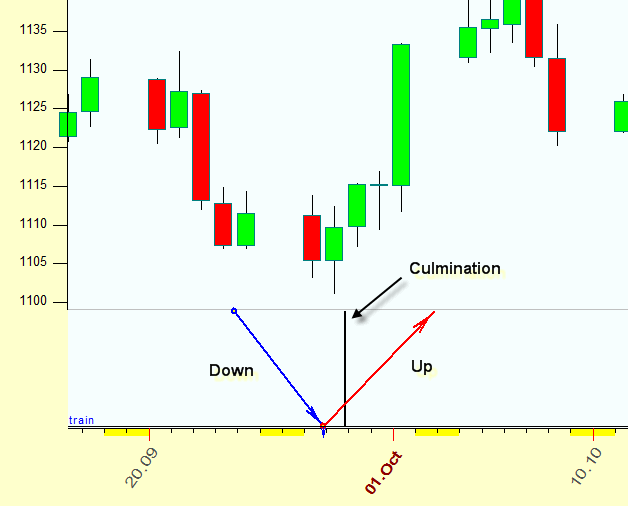
What does this mean to us? It means that - after a proper research - we can have a list of different astrological aspects or phenomena and their effect on some chosen financial instrument. Each one aspect or phenomenon from such a list would be telling us some information about this market (S&P 500 futures in our example). And we can make models based on each aspect separately.
Will this be useful? I do not think so. In real life we never have just one aspect working at some particular moment. Every moment we have a lot of astrological/astronomical phenomena going. And very often these phenomena contradict to each other. At the same period of time, some aspects may show one future direction of the price while others will show a totally different price movement. So, to be able to use this useful astro information (again, based on research and observation), we have to find a way of dealing with many (if not all) phenomena at the same time.
We propose a way to display the summary effect of all these aspects. Here it is:
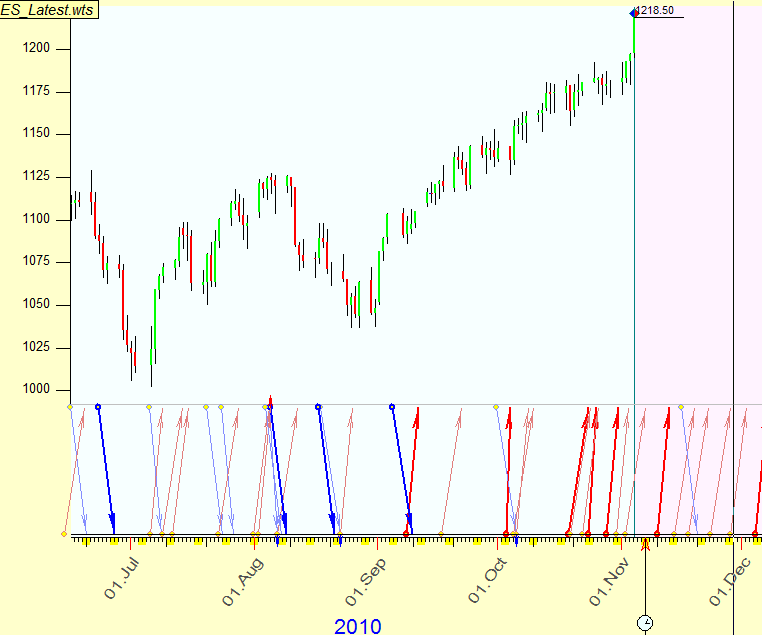
We call this diagram "Easy Expert" chart, it shows the up/down arrows of all involved astrological/astronomical phenomena.
Instead of looking at arrows provided by just one aspect. we look at the clusters of the arrows of similar color. Thus the big density of blue arrows indicates a probable downward movement, while a cluster of red arrows indicates a probable up movement. Moreover we can also see "conflict" zones where many blue and red arrows are presented, like here:
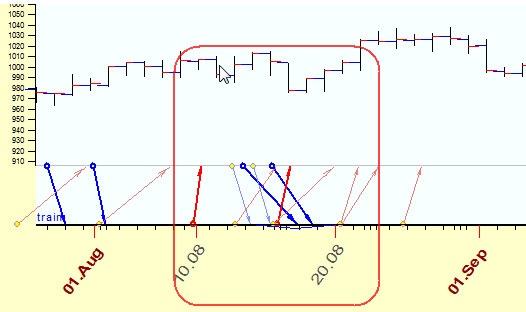
Therefore, we can estimate risky periods (which are the periods with contradictingt signals.
Fast Start
It is easy to work with Easy Expert module. As the first step, define the astrological/astronomical phenomena that will be used to calculate these arrows. It can be any events: aspects, midpoints, ingresses and many many others. Put them into the list after thorough consideration (after looking at their Efficiency Tests, etc). These events should met just two requirements: a) be applicable for forecasting (it means that there should be a strong statistical evidence of the event's affect on the market); b) be instantaneous (i.e. you can consider aspect's culmination, and not the aspect in orb, or ingress of some planet into some Zodiac sign and not a planet's position in this Zodiac sign)c.
You can define these events by clicking on this button:
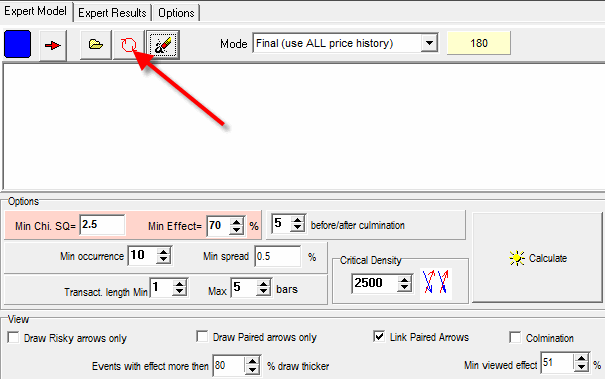
The program will open for you already familiar window "Choices of Criteria", where you can define the bunch of astrological/astronomical events.
In our example we use Ptolemy aspects, and this is the form used to define them:
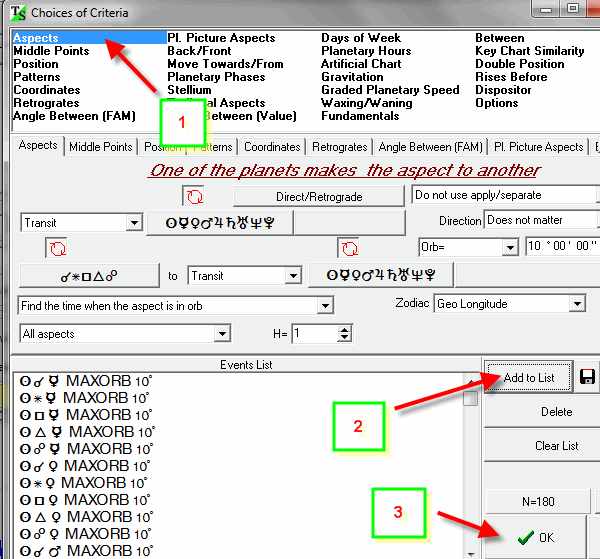
You can also download previously created *.hyp files with stored events
clicking this button: ![]()
Now you need to click "Calculate" button, and you will get the Easy Expert chart on the Main screen:
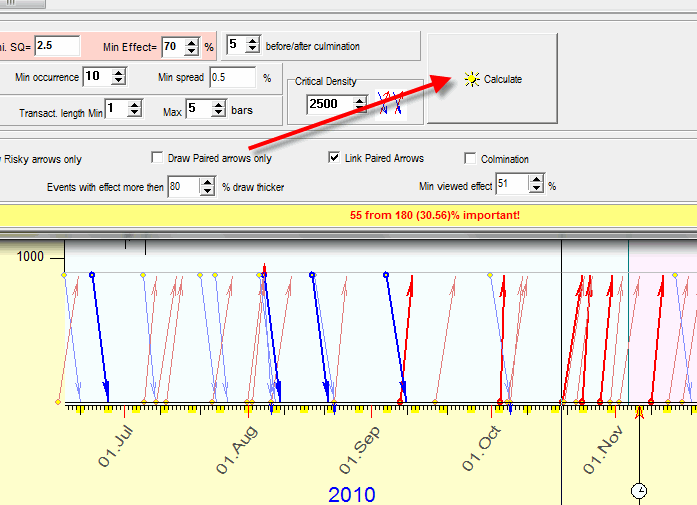
Advanced
Easy Expert chart consists of many up and down arrows. While working with it, you may need to know what aspect some particular arrow belongs to. This information is valuable because it provides some hints regarding the nature of this arrow/aspect and may be used for forecasting..
You can obtain this information by pushing this button: ![]() in Easy Expert module; then simply click your mouse on the Main screen on the small
cycle in the beginning of the chosen arrow:
in Easy Expert module; then simply click your mouse on the Main screen on the small
cycle in the beginning of the chosen arrow:
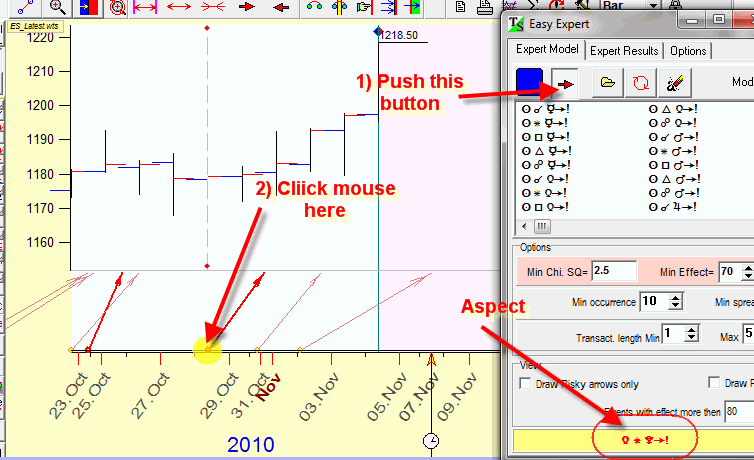
The information about the corresponding aspect will be displayed in the bottom panel of Easy Expert module. Moreover following "Experts Results" tab you will get the detailed information about this aspect:
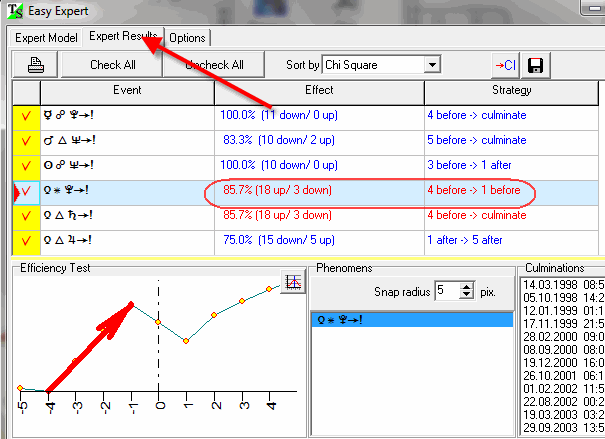
Here you can see how many times the price went up or down as well as the Efficiency Test calculated for this aspect.
There is also the possibility to modify Easy Expert chart: you can choose manually what aspects from the list should be displayed there. To disable/enable any aspect, simply make double mouse click on the cell with the information about this aspect:
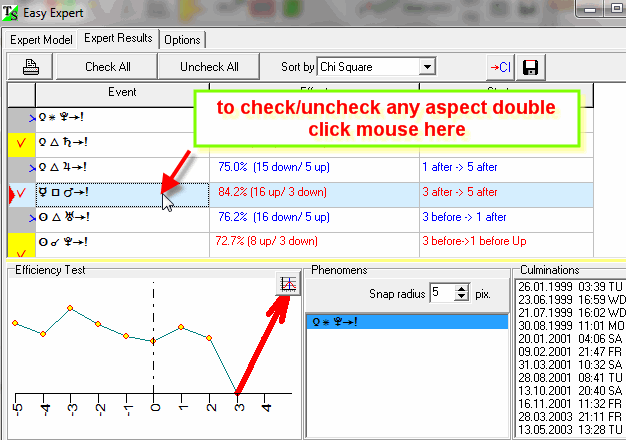
You can also emphasize some arrows making them thicker by varying this option:
![]()
In this example the arrows with the effect 80% and higher are shown thicker than other arrows. The effect is the percentage of "right" directions, for example if the price goes up 8 times versus 2 downs we have the efficiency of this phenomenon 80%.
How the program picks us aspects/phenomena
Here are recommendations on how to pick up the most important events for daily data:
a) Do not download the whole available price history; you need to have at least 4 years of price history, better 8-12 years price history = and no more than that. The reason is simple: the stock market 20 years ago and that same market now are different entities; and the effect of astro phenomena may be different as well as different patterns may be in play.
b) Better avoid to analyze "one trend" historical data, i.e. time intervals with one trend dominating. However, for for some instruments (for example T-Bonds) this is impossible to achieve. The dominant trend is shown on the right side of Easy Expert window:

We call this parameter Asymmetry, in our example asymmetry is 69%, i.e. bulls play 69% time in this market. The closer asymmetry is to 50% the better, this way we put bears and bulls in equal starting position.
For example, this piece of price history is good for Easy Expert module as we have here a lot for bulls and bears (asymmetry=57% Up):
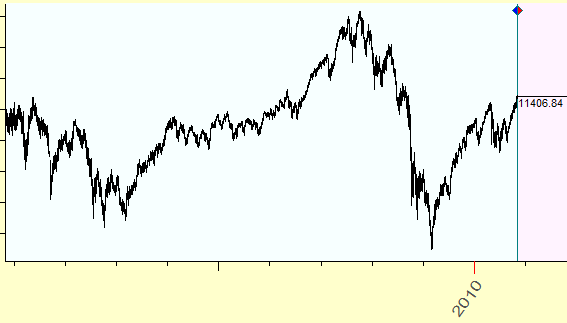
On the contrary, this piece of price history is not good for Easy Expert module, there is too much "negative" experience here. The model based on this experience will predict crashes only, some positive view has to be added:
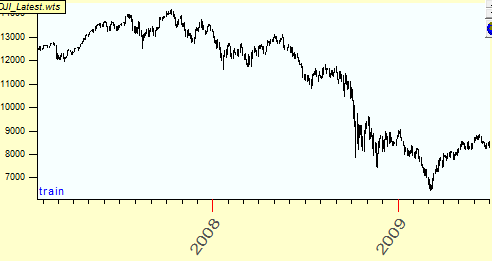
c) To filter our phenomena we use these parameters: ![]()
small sample size (<30)
If the analyzed phenomenon (suppose we analyze some aspect) occurs inside the analyzed price history data less than 30 times, we use factor analysis, we analyze the effect of this phenomena. For example: if the price goes UP 8 times versus 2 times DOWN, the effect of this phenomena is 80%, i.e. the price goes UP in 80% cases.
You have to watch the "Min Effect" parameter only, it should be higher than asymmetry value:
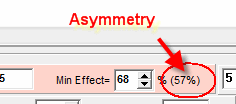
BTW, the program shows the effect of analyzed phenomena here:
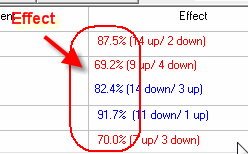
big sample size (>30)
If the analyzed phenomenon occurs more than 30 times, we use statistical Chi. Sq. criteria The program displays Chi square value here:

You can use this criteria:
| less than 2.5 | poor but tradable |
| 2.5-3.0 | average |
| 3.0-4.0 | good |
| higher than 4.0 | very good |
other parameters

![]() - the effect of
some aspect is restricted by 10 days (in this example) starting 5 days before
culmination, ending 5 days after culmination);
- the effect of
some aspect is restricted by 10 days (in this example) starting 5 days before
culmination, ending 5 days after culmination);
![]() - the
analyzed phenomena should occur 10 times at least (as in the example above). If this
value is too small, the random error may be high;
- the
analyzed phenomena should occur 10 times at least (as in the example above). If this
value is too small, the random error may be high;
![]() - range for the transaction length. Take it as
the length of arrows. For example if our strategy
recommends buying 2 days before the culmination and selling 5 days after the culmination.
You can try to increase this value, try to create a longer strategy.
- range for the transaction length. Take it as
the length of arrows. For example if our strategy
recommends buying 2 days before the culmination and selling 5 days after the culmination.
You can try to increase this value, try to create a longer strategy.
![]() - the maximum
value of arrows that can be displayed on the screen. If this value is to big, we
can get a very messy view.
- the maximum
value of arrows that can be displayed on the screen. If this value is to big, we
can get a very messy view.
Creating TS Calendars
For your practical trading, it would be good to have some tool that allows to do a fast preview of all important astronomical/astrological phenomena. Back to our example with Mercury-Jupiter aspect, it would be good to be advised 5 days before this aspect culminates as the downtrend is expected (you can see it from Efficiency Test histogram):

Timing Solution Calendar module has been developed for these needs. In order to create TS Calendar simply click this button:
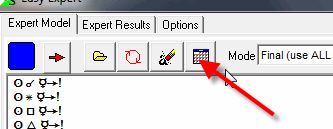
In a moment you will get TS Calendar with the most important upcoming events:
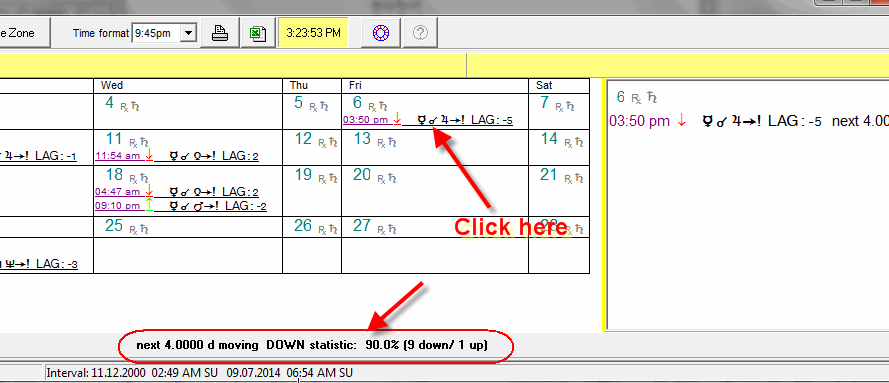
Look at the record for Mercury conjuncting Jupiter aspect; it is shown on the calendar five days before its culmination (because the aspect's LAG=-5). Click on this record and you will see the effect of this aspect - next 4 days the price tends to go down.
Creating projection line based on Easy Expert module
You can use Easy Expert module as a filter to pick up the most important events and use these events as input for Neural Network or Events Box module. Clicking this button you will put the most important events into clipboard:
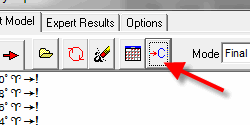
After that you can use these events in Neural Network this way:
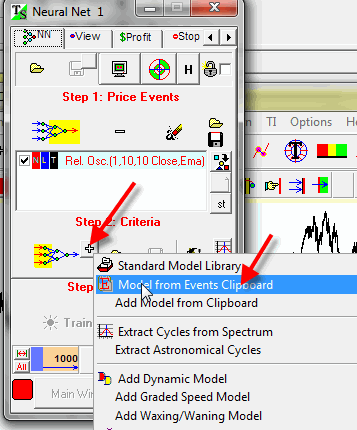
Examples
....